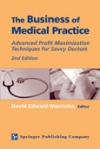Building Medical Practice Value
 By Dr. David Edward Marciniko MBA
By Dr. David Edward Marciniko MBA
In the competitive environment an equity-advantaged medical practice is not likely going to come from adding more HMO / ACO patients as a business strategy, or shifting your target market. You do it by making your practice worth buying to someone else.
In other words, a brand identity is the hallmark of increased practice value in the future. But, just what determines practice equity since there is no magic rule of thumb?
Creating Practice Value
The following helpful general suggestions are offered by valuation specialist Mark Tibergien CPA, formerly of the accounting firm Moss-Adams LLP, and have been modified below for medical practitioners regardless of degree or specialty designation:
· Maintain good financial records including all consolidated accounting statements for the last three years. Learn what was budgeted, what was spent, and what was at variance.
· Monitor key specialty financial ratios, such as profitability ratios, creditor ratios and long-term debt management ratios. Continually mine the data for useful information and then implement changes on your own behalf.
· Be profitable and think long term by retaining capital and generating a business return.
· Eliminate unnecessary practice expenses or non-recurring costs and eliminate any special perks of business ownership.
· Have a buy-sell agreement since it spells out the manner in which a physician can buy into the practice and how the practice will buy out an owner. Typically, buy-sell agreements also cover such topics as appraisal and valuation methods, accounts receivable equalization, excess earnings (profits) distribution, buy in/out time span, interest rate ranges, goodwill rates, tax deductibility of buyout payments and a host of other issues import to the involved principals. Have it reviewed once every one to two years.
· Pay yourself a usual, customary and reasonable salary for your specialty. Otherwise practice [business] goodwill value may be built-up, or depleted.
· Practice using the correct business form for you. This may be as either as a sole proprietor, general partnership, S corporation, professional corporation, C corporation or limited liability corporation/partnership.
· Build a transferable patient base because if you create systems that revolve around either a few managed care contracts, or even yourself, it is difficult to transfer the business to someone else. Also, if you project yourself as the medical guru for your area, patients will have a hard time accepting a new doctor or organization. By focusing on something larger than yourself, such as group practice, you will begin to develop a business that others can operate easily.
· Use proper management information systems like EMRs without spending too much on your information technology gadgetry. You do not necessarily need to become an early adopter of the newest or untested information technology systems, but do become an adopter of mature products.
· Have a covenant not to compete, which is an agreement whereby one party commits himself to not practicing for a period of time, within a geographical area, or with members of a defined population. According to healthcare law expert Frederick Wm. LaCava; Ph.D, JD, arguments can arise because of two sets of circumstances: [1] sale of a practice, or [2] as a term of an employment agreement. The law treats the two types quite differently, favoring agreements as part of the sale of a practice, and entertaining challenges to covenants in employment contracts.
· Understand that practice [business] goodwill is the value attributed to ongoing business name recognition, location, telephone numbers, logos and all those things which would make a potential patient come to one doctor’s office rather than another’s. The IRS recognizes it as an economic as well as a value-added benefit.
· Unlike practice [business] goodwill, personal goodwill is attributed to a specific doctor; it has little to no value since it “goes to the grave” with its attributor.
· Maintain services, responsiveness and consistency with your patients and referring doctors. This is critical because if you do not build strong relationships with these local players, premium value just isn’t there. A new doctor will not be able to rely on those established relationships going forward.
· Maintain compliance with all appropriate agencies [HIPAA, OSHA, EMTALA, EEOC, etc].
· Identify the right buyer and make sure the buyer has the necessary capital and you are not taking all of the risks in the transaction. You may or may not want to share financial risk with the buyer and you also may want a good personality match, since your life blood probably went into building the practice and you should want it to flourish going forward.
Assessment
Develop a forward thinking business and appraisal plan, since all doctors should plan to sell their practices at some point in the future. By understanding how practices are valued, you can create tremendous value for yourself.
Conclusion
Contemporary physicians have a huge opportunity to build equity value into their medical practice. Whether or not this is becomes a reality – by focusing on creating maximum value – you can still design and modify your practice to enhance its value and achieve everything dreamed about when it was first begun, many years ago.
***


Filed under: Practice Management | Tagged: Health Economics | Leave a comment »




















